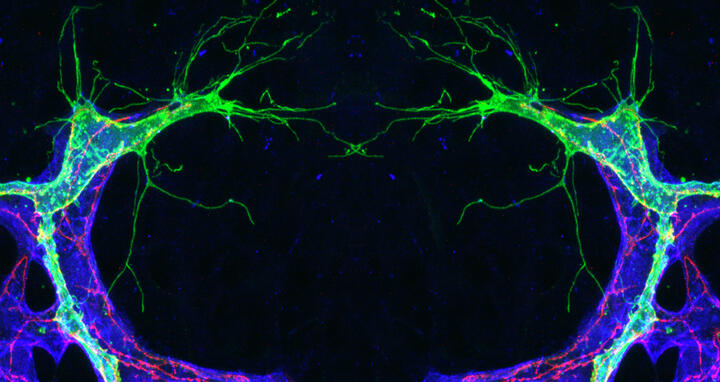How the heart and blood vessels influence organs
Joint press release by the Max Delbrück Center and Heidelberg University
The human heart is much more than a pump, and blood vessels are far more than just conduits for transport. “We now know that together they form a kind of communication hub and exchange information with all other organs,” says Professor Norbert Hübner, Head of the Genetics and Genomics of Cardiovascular Diseases research group at the Max Delbrück Center in Berlin. “They can thus either promote health or contribute to disease.” However, exactly how this happens and the molecular signals involved remain largely unexplored.
More than 150 researchers from around the world
To answer such questions, Hübner and his colleagues Professor Gergana Dobreva and Professor Johannes Backs have organized the first international conference of the Helmholtz Institute for Translational AngioCardioScience (HI-TAC), which was founded in 2023: On April 28 and 29, more than 150 researchers from all over the world will come together at Heidelberg University to exchange knowledge.
Dobreva heads the Cardiovascular Genomics and Epigenomics department at the Medical Faculty Mannheim of Heidelberg University. Backs is Director of the Institute for Experimental Cardiology at the Medical Faculty Heidelberg of Heidelberg University and Heidelberg University Hospital. HI-TAC is an external branch of the Max Delbrück Center based at the campus of Heidelberg University. The Berlin-based Max Delbrück Center and the Medical Faculties of Mannheim and Heidelberg of Heidelberg University jointly founded HI-TAC to pool their expertise in cardiovascular and system biology. Hübner, Dobreva, and Backs are the interim Scientific Directors of HI-TAC.
The key to healthy aging
“The dynamic interplay between the cardiovascular system and other organs appears to be the key to healthy aging,” says Dobreva. Groundbreaking discoveries have recently been made in both heart and vascular biology. Yet, despite their close biological connection, the two research areas have mostly advanced along separate paths.
“With our symposium, we want to bring together leading minds from both disciplines to facilitate an inspiring exchange, encourage new collaborations, and build a strong interdisciplinary community for AngioCardioScience,” says Dobreva. “By bridging the gap between heart and vascular research, we aim to establish a creative think tank that fosters new insights into disease mechanisms and drives technological innovations as well as therapeutic advances.”
Still a relatively young research field
A rendering of the planned HI-TAC Building on the campus of the University Medical Center Mannheim.
“I am particularly looking forward to discussions about how we could work together in an interdisciplinary fashion in the future so that we not only gain new insights, but also use them to develop novel therapies for diseases that affect multiple organs at once,” says Backs. Achieving this goal will require venturing into uncharted territory: “HI-TAC will build international networks to establish and develop the new field of AngioCardioScience worldwide.”
Hübner is especially pleased that so many outstanding international speakers will be participating in the Heidelberg meeting. All three warmly invite interested researchers to attend the conference: “Help us shape the future of AngioCardioScience!” says Dobreva. “This is where scientific curiosity, pioneering spirit, and collaboration come together.”
Note to editors
Media representatives are warmly invited to attend and report on the event. Registration is required at presse@mdc-berlin.de
HI-TAC Spring Symposium – Angioscience meets Cardioscience
When?
Monday, April 28, 2025, 11:00 AM through Tuesday, April 29, 2025, 4:00 PM
Where?
Heidelberg University Grabengasse 1 & 3-5
Day 1: Great Hall of the Old University | Day 2: Great Hall of the New University 69117 Heidelberg
Further information
Pictures for download
Microscopic image of sprouting blood vessels in the retina of the eye. Shown in green are individual endothelial cells that are creating new vessels and forging new connections between vessels. All endothelial cell membranes are stained blue, while magenta highlights the inner membrane of these cells. Photo: Claudio Franco, Max Delbrück Center
A rendering of the planned HI-TAC Building on the campus of the University Medical Center Mannheim. Photo: HASCHER JEHLE Architektur / loomn architekturkommunikation
Contacts
Jana Schlütter
Editor, Communications
Max Delbrück Center
+49 30 9406 2121
jana.schlütter@mdc-berlin.de or presse@mdc-berlin.de
Kommunikation und Marketing Universität Heidelberg
Universität Heidelberg
+49 6221 54-2311
presse@rektorat.uni-heidelberg.de
- HI-TAC
The Helmholtz Institute for translational AngioCardioScience (HI-TAC) is an external branch of the Max Delbrück Center based at the campus of Heidelberg University. The Berlin-based Max Delbrück Center and the Medical Faculties of Mannheim and Heidelberg of Heidelberg University jointly founded HI-TAC to pool their expertise in cardiovascular and system biology.
- Max Delbrück Center
The Max Delbrück Center for Molecular Medicine in the Helmholtz Association aims to transform tomorrow’s medicine through our discoveries of today. At locations in Berlin-Buch, Berlin-Mitte, Heidelberg and Mannheim, our researchers harness interdisciplinary collaboration to decipher the complexities of disease at the systems level – from molecules and cells to organs and the entire organism. Through academic, clinical, and industry partnerships, as well as global networks, we strive to translate biological discoveries into applications that enable the early detection of deviations from health, personalize treatment, and ultimately prevent disease. First founded in 1992, the Max Delbrück Center today inspires and nurtures a diverse talent pool of 1,800 people from over 70 countries. We are 90 percent funded by the German federal government and 10 percent by the state of Berlin.
- University of Heidelberg
Founded in 1386, Ruperto Carola is an internationally oriented research university whose subject spectrum includes the humanities, the social sciences, law, the natural, engineering and life sciences, and medicine. As one of the Universities of Excellence in Germany, Heidelberg University’s successes in the Excellence Competitions and its standing in international rankings confirm its leading role in the academic landscape. It is part of Heidelberg University’s self-concept to further develop outstanding individual disciplines, to strengthen interdisciplinary cooperation, and to carry research results over into society. With a research-oriented course of study in more than 190 programs, its nearly 30,000 students can choose from a virtually singular array of subject combinations and individual qualification pathways.




